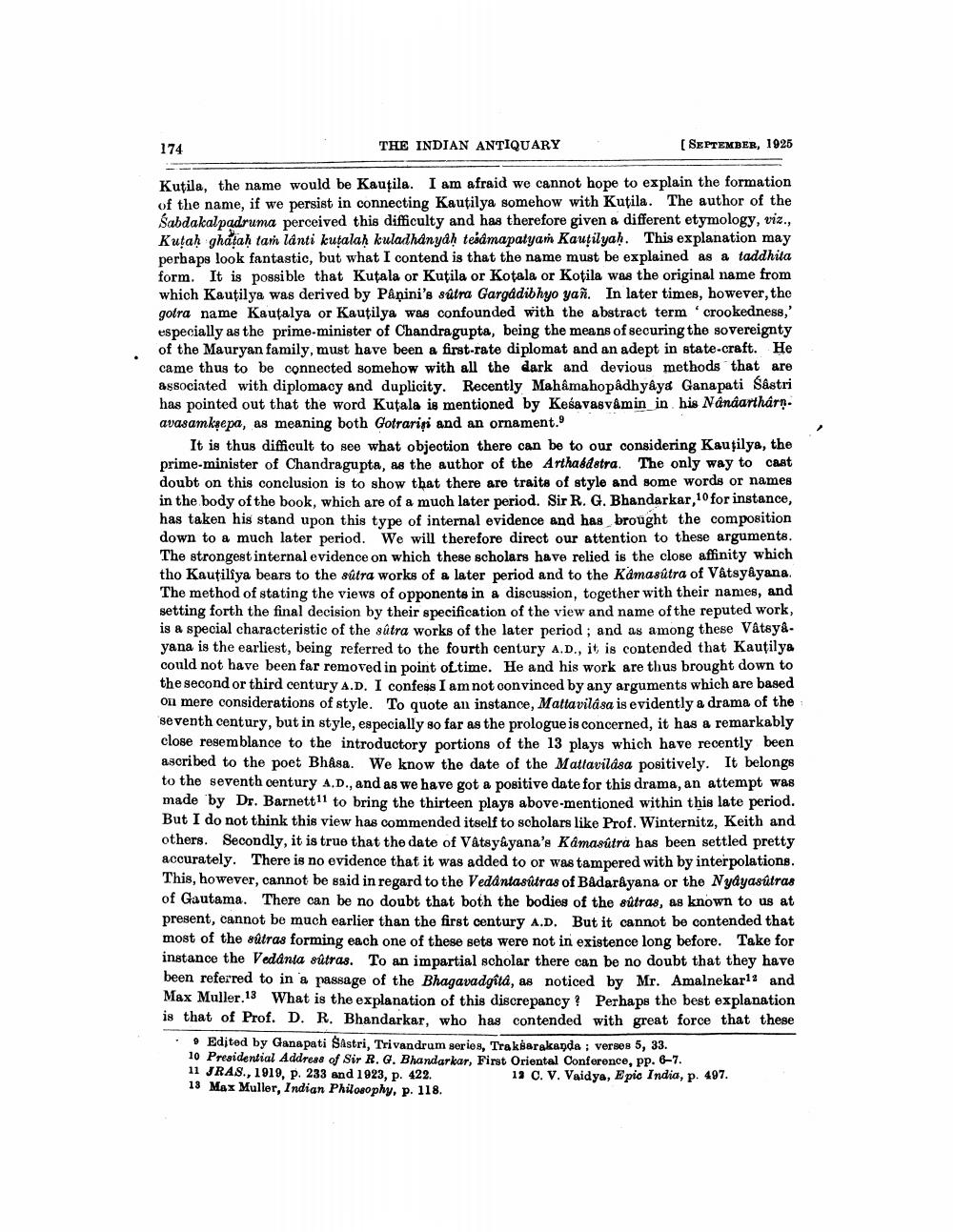________________
174
THE INDIAN ANTIQUARY
[ SEPTEMBER, 1925
Kutila, the name would be Kauțila. I am afraid we cannot hope to explain the formation of the name, if we persist in connecting Kautilya somehow with Kutila. The author of the Sabdakal padruma perceived this difficulty and has therefore given a different etymology, viz., Kutah ghatah tam lánti kutalah kuladhanyah tesâmapatyan Kautilyah. This explanation may perhaps look fantastic, but what I contend is that the name must be explained as a taddhita form. It is possible that Kutala or Kuţila or Kotala or Kotila was the original name from which Kautilya was derived by Påņini's sútra Gargadibhyo yan. In later times, however, the gotra name Kautalya or Kautilya was confounded with the abstract term crookedness,' especially as the prime minister of Chandragupta, being the means of securing the sovereignty of the Mauryan family, must have been a first-rate diplomat and an adept in state-craft. He came thus to be connected somehow with all the dark and devious methods that are associated with diplomacy and duplicity. Recently Mahamahopadhyâya Ganapati Sastri has pointed out that the word Kutala is mentioned by Keśavasvamin in his Nanâarthårn. avasam krepa, as meaning both Gotrarini and an ornament.
It is thus difficult to see what objection there can be to our considering Kautilya, the prime-minister of Chandragupta, as the author of the Arthasdetra. The only way to cast doubt on this conclusion is to show that there are traits of style and some words or names in the body of the book, which are of a much later period. Sir R. G. Bhandarkar, 10 for instance, has taken his stand upon this type of internal evidence and has brought the composition down to a much later period. We will therefore direct our attention to these argumente. The strongest internal evidence on which these scholars have relied is the close affinity which tho Kautiliya bears to the sutra works of a later period and to the Kamasútra of Vatsyâyana, The method of stating the views of opponents in a discussion, together with their names, and setting forth the final decision by their specification of the view and name of the reputed work, is a special characteristic of the sůtra works of the later period, and as among these Vatey&. yana is the earliest, being referred to the fourth century AD, it is contended that Kautilya could not have been far removed in point oftime. He and his work are thus brought down to the second or third century A.D. I confess I am not oonvinced by any arguments which are based on mere considerations of style. To quote an instance, Mattavilása is evidently a drama of the seventh century, but in style, especially so far as the prologue is concerned, it has a remarkably close resemblance to the introductory portions of the 13 plays which have recently been ascribed to the poet BhAsa. We know the date of the Mattavildsa positively. It belonge to the seventh century A.D., and as we have got a positive date for this drama, an attempt was made by Dr. Barnett11 to bring the thirteen plays above-mentioned within this late period. But I do not think this view has commended itself to scholars like Prof. Winternitz, Keith and others. Secondly, it is true that the date of Vâtsyâyana's Kámasútra has been settled pretty accurately. There is no evidence that it was added to or was tampered with by interpolations. This, however, cannot be said in regard to the Vedantasútras of Badar yana or the Nydyasútras of Gautama. There can be no doubt that both the bodies of the sutras, as known to us at present, cannot be much earlier than the first century A.D. But it cannot be contended that most of the sûtras forming each one of these sets were not in existence long before. Take for instance the Vedanta sútras. To an impartial scholar there can be no doubt that they have been referred to in a passage of the Bhagavadgita, as noticed by Mr. Amalnekarls and Max Muller. 13 What is the explanation of this discrepancy? Perhaps the best explanation is that of Prof. D. R. Bhandarkar, who has contended with great force that these • Edited by Ganapati Sastri, Trivandrum series, Trakbarakanda ; verses 5, 33.
10 Presidential Address of Sir R. G. Bhandarkar, First Oriental Conference, pp. 6-7. 11 JRAS., 1919, p. 233 and 1923, p. 422.
12 C. V. Vaidya, Epic India, p. 497. 18 Max Muller, Indian Philosophy, p. 118.




